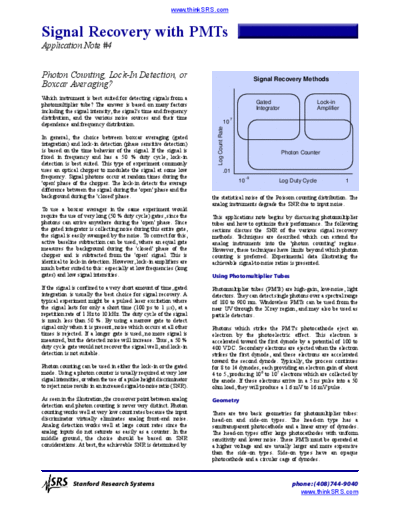Service Manuals, User Guides, Schematic Diagrams or docs for : Stanford Research Systems www.thinksrs.com-SignalRecovery
<< Back | HomeMost service manuals and schematics are PDF files, so You will need Adobre Acrobat Reader to view : Acrobat Download Some of the files are DjVu format. Readers and resources available here : DjVu Resources
For the compressed files, most common are zip and rar. Please, extract files with Your favorite compression software ( WinZip, WinRAR ... ) before viewing. If a document has multiple parts, You should download all, before extracting.
Good luck. Repair on Your own risk. Make sure You know what You are doing.
Image preview - the first page of the document

>> Download www.thinksrs.com-SignalRecovery documenatation <<
Text preview - extract from the document
www.thinkSRS.com
Signal Recovery with PMTs
Application Note #4
Photon Counting, Lock-In Detection, or Signal Recovery Methods
Boxcar Averaging?
Which instrument is best suited for detecting signals from a
photomultiplier tube? The answer is based on many factors Gated Lock-in
Integrator Amplifier
including the signal intensity, the signal's time and frequency
distribution, and the various noise sources and their time 7
dependence and frequency distribution. 10
Log Count Rate
In general, the choice between boxcar averaging (gated
integration) and lock-in detection (phase sensitive detection)
is based on the time behavior of the signal. If the signal is Photon Counter
fixed in frequency and has a 50 % duty cycle, lock-in
detection is best suited. This type of experiment commonly
uses an optical chopper to modulate the signal at some low .01
frequency. Signal photons occur at random times during the -9
'open' phase of the chopper. The lock-in detects the average 10 Log Duty Cycle 1
difference between the signal during the 'open' phase and the
background during the 'closed' phase. the statistical noise of the Poisson counting distribution. The
analog instruments degrade the SNR due to input noise.
To use a boxcar averager in the same experiment would
require the use of very long (50 % duty cycle) gates, since the This applications note begins by discussing photomultiplier
photons can arrive anywhere during the 'open' phase. Since tubes and how to optimize their performance. The following
the gated integrator is collecting noise during this entire gate, sections discuss the SNR of the various signal recovery
the signal is easily swamped by the noise. To correct for this, methods. Techniques are described which can extend the
active baseline subtraction can be used, where an equal gate analog instruments into the 'photon counting' regime.
measures the background during the 'closed' phase of the However, these techniques have limits beyond which photon
chopper and is subtracted from the 'open' signal. This is counting is preferred. Experimental data illustrating the
identical to lock-in detection. However, lock-in amplifiers are achievable signal-to-noise ratios is presented.
much better suited to this: especially at low frequencies (long
gates) and low signal intensities. Using Photomultiplier Tubes
If the signal is confined to a very short amount of time, gated Photomultiplier tubes (PMTs) are high-gain, low-noise, light
integration is usually the best choice for signal recovery. A detectors. They can detect single photons over a spectral range
typical experiment might be a pulsed laser excitation where of 180 to 900 nm. Windowless PMTs can be used from the
the signal lasts for only a short time (100 ps to 1 ◦ Jabse Service Manual Search 2024 ◦ Jabse Pravopis ◦ onTap.bg ◦ Other service manual resources online : Fixya ◦ eServiceinfo